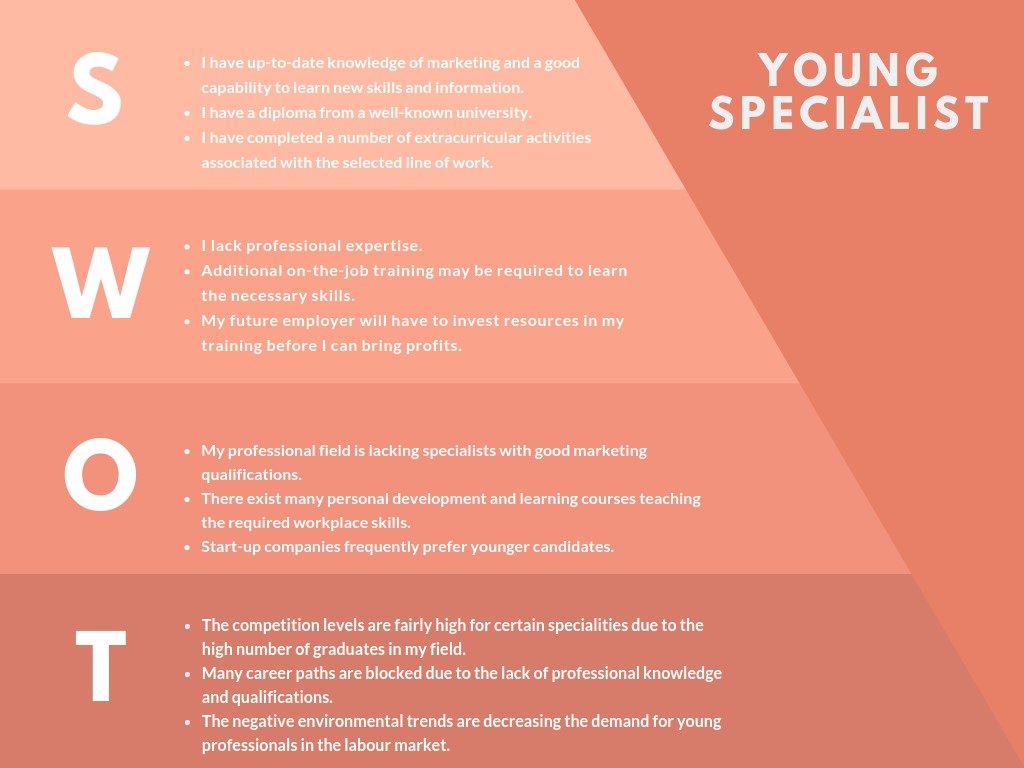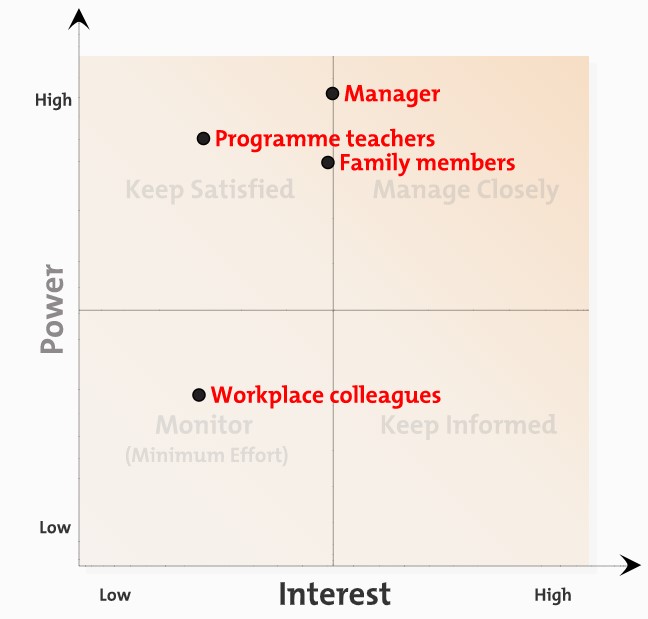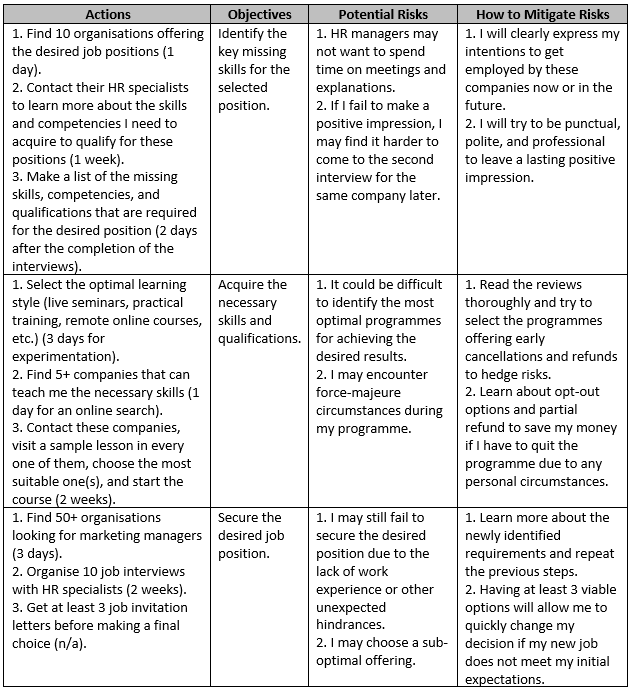Written by Laura N
Executive Summary
This report outlines the constituent elements of a personal development and learning plan including SWOT and PESTLE analyses, stakeholder mapping, and SMART goal-setting. This evaluation provides an in-depth understanding of individual barriers to realising the career aspirations of a young specialist in the labour market. Additionally, the author appraises the learning process and the ways of its optimisation. The sample analysis is performed from the standpoint of a university graduate and outlines the decision-making process in the conditions of maximal uncertainty and a variety of viable options. The concluding section of this report presents a table with the finalised action plan outlining the key objectives with constituent actions necessary for their achievement as well as the possible risks and risk mitigation strategies.
Introduction
Many university graduates in the UK find themselves out of their depth in terms of securing a good job position and mapping the course of their future professional development (FT, 2019). Unfortunately, the effectiveness of this process largely depends on the capability to appraise the maximal number of internal and external factors and build an effective career advancement strategy (Rimmer, 2018). The author of this report seeks to secure the position of a marketing manager in a UK organisation as a university graduate with limited work experience. The following sections outline the steps that will be utilised to successfully realise this goal via personal development and learning.
An Appraisal of Self
The revision of internal resources is deemed by the author to be the most optimal first step. It will allow the candidate to appraise which future goals may be realistic in the short-term and medium-term perspective and how much effort will be required to achieve them. The author of this assignment has utilised the traditional SWOT framework that is used by thousands of marketers to evaluate the strengths, weaknesses, opportunities, threats of their organisations (Fleisher and Bensoussan, 2015).
Figure 1: SWOT Analysis
Source: Alsop (2015, n.p.); CIPD (2019, n.p.); FT (2019, n.p.)
The completed SWOT analysis has helped me to deepen my understanding of the key skill deficiencies that may prevent me from getting the desired position. While I am presently working part-time developing marketing materials and presentations for several organisations as a freelancer, I clearly lack the certifications and professional expertise necessary to apply for the position of a marketing manager at a well-established organisation.
Environmental Analysis
The next logical step in my planning is the analysis of the labour market. This is necessary to identify the existing demand patterns, employer expectations, and available opportunities (Yeomans and Rogers, 2017). Since Porter’s Five Forces and similar frameworks seemed more suitable for organisations, I have chosen to conduct a PEST analysis for this purpose. This model will allow me to appraise the 2016-2017 situation in the UK labour market from the standpoint of the political, economic, social, and technological factors that could affect my plans (West et al., 2015).
Political
The post-Brexit uncertainty is presently affecting the career prospects of EU citizens working in the UK since it is not clear if they can remain in the country without undergoing additional visa application procedures (Moschieri and Blake, 2019). This can make me more attractive as a candidate since I am a UK citizen and my recruitment will not be associated with any potential work permit problems in the future.
Economic
The depreciating national currency and other economic problems are making it difficult for me to pay off my student loans and survive as a post-graduate (Bulmer and Quaglia, 2018). Hence, my career development path will have to be as steady as possible, which will require a part-time or full-time job in addition to my personal advancement and learning activities.
Social
The 2019 CIPD Working Lives report (CIPD, 2019) has identified that the UK ranked low in terms of work-life balance since 60% of the studied employees had to overwork. This could be a problem for integrating training sessions into my part-time or full-time employment schedule.
Technological
The high level of technological development in the UK allows students and young professionals to complete various forms of online training, obtain certificates confirming their skills in different areas, and apply for multiple positions across the country (Sharma and Garg, 2019). This may be beneficial for analysing available remote learning programmes and apply for remote working vacancies.
Goal-Setting
The concept of SMART goals implies that any objectives must be specific, measurable, achievable, realistic, and time-bound (Ogbeiwi, 2017). This is very important for building a personal development plan since many people fail in their career advancement due to setting excessively broad goals such as ‘become a better marketing specialist’ or the goals that are not time-bound. My SMART objectives are formulated as follows,
- Identify the key missing skills for the selected position within the following 2 weeks.
- Acquire the necessary skills and qualifications within the following 3-6 months.
- Secure the desired job position within 1-2 months after completing step 2.
As I was outlining these objectives, I discovered an interesting pattern. Detailed planning made the objectives feel substantially more achievable. This is related to the ‘actionable’ and ‘realistic’ characteristics of SMART (Rowe et al., 2017). A well-formulated goal has become a self-fulfilling prophecy since I could start making some small steps to achieve it right away, which increases my motivation. To make my objectives even more realistic, I have decided to implement the concept of ‘stakeholders’.
Stakeholder Mapping
According to the theory of Freeman (1999), stakeholders are all parties involved in the realisation of some activities or influenced by their real or possible outcomes. For example, the construction of an environmentally dangerous chemical plant may be highly beneficial for its owners but potentially devastating for local communities. The benefits of this theory for personal development are related to the fact that personal goals may create viable gains for multiple third parties. Hence, they can be convinced to support you with their resources in exchange for future benefits, which can reduce the time-to-realisation manifold and add powerful leverage (Slaba, 2016). In my case, I will have to coordinate my training schedule with the manager of my present employer to avoid the situations when overtime work can overlap with my personal development sessions. Similarly, I will have to win the support of my family members since additional training will be scheduled for evening periods and weekends. I need to ‘sell’ my goals to them in order to convince them that I can realise them within half a year approximately. One of the possible selling points is the fact that the new position of a marketing manager will increase my salary and my contribution to the family budget. Overall, I mapped the four ‘quadrants’ of stakeholders shown in the following figure in terms of the need to keep them informed about my progress and their interest in its outcomes.
Figure 2: Stakeholder Map
Source: Created for this assignment
Learning Styles Selection
According to modern researchers, there are more than 70 models describing the ways we learn new information and skills (Guardian, 2017). One of the most popular ones is the learning cycle framework that was developed by Kolb (2015). It assumes that the acquisition of new skills and competencies involves several consequent stages, namely the first-hand experience of some activity, the reflection upon this experience, the conclusions and theoretical assumptions based on this reflection, and the verification of these concepts in similar situations. Additionally, people differ in their patterns of understanding and processing information depending on their abstract conceptualisation capabilities or the preference of active experimentation. From the standpoint of this system, I am clearly an accommodator since I have been relying on practical experiments and problem-solving throughout my university years and part-time work. This makes remote learning programmes less interesting to me since I feel that I need direct supervision and real-life training to advance my skills as a future marketing manager.
Action Plan Development
The previous steps have identified the key strengths and weaknesses, the strategies for addressing internal and external threats, and the key stakeholders that could provide assistance with my personal development and learning. Now, I need to finalise my action plan by developing the SMART actions required to realise my objectives and conduct a brief analysis of potential risks and the ways to mitigate them (Johnston, 2017). For example, I may fail to complete the selected training course in the case of health problems or urgent workplace issues. While I cannot predict and mitigate all potential threats, I need to have a ‘Plan B’ that will keep me on the set course even if I have to take several steps back (Aquila and Rice, 2017). Actually, I may also have to revise some of the goals in the process to address the newly emerging challenges or some critical findings made during my learning sessions. Hence, the following plan will be formulated from my current standpoint and may need adjustments as I gain more insight and expertise in my selected area of personal development.
Table 1: Action Plan
Conclusion
Realising your career aspirations is not an easy feat and many people fail to secure the positions that they want (FT, 2019). The main problem here is the misunderstanding of the needs of prospective employers and the practical steps that must be taken to become the ideal candidate for them (Rimmer, 2018). This is exactly why the suggested action plan involves contacting the HR specialists before finalising my learning plan. According to the reviews of other candidates found online, some of the requirements and recommendations obtained during their job interviews provided unique insights into the expectations and needs of the employers. This can make it substantially easier for me to pinpoint the key core competencies I need to develop, create SMART learning goals, and realise them without wasting extra time and resources (Ogbeiwi, 2017). The integrated fail-safe elements will also allow me to quit a certain programme if I encounter any force majeure circumstances or understand that it does not fulfil the intended purpose.
References
Alsop, R. (2015) “This is the real reason new graduates can’t get hired”, [online] Available at: https://www.bbc.com/worklife/article/20151118-this-is-the-real-reason-new-graduates-cant-get-hired [Accessed on 14 October 2019].
Aquila, A. and Rice, C. (2017) Performance Is Everything: The Why, What, and How of Designing Compensation Plans, Hoboken: John Wiley & Sons.
Bulmer, S. and Quaglia, L. (2018) “The politics and economics of Brexit”, Journal of European Public Policy, 25 (8), pp. 1089-1098.
CIPD (2019) “UK Working Lives”, [online] Available at: https://www.cipd.co.uk/Images/uk-working-lives-summary-2019-v1_tcm18-58584.pdf [Accessed on 17 October 2019].
Fleisher, C. and Bensoussan, B. (2015) Business and competitive analysis: effective application of new and classic methods, New York: FT Press.
Freeman, R. (1999) “Divergent stakeholder theory”, Academy of Management Review, 24 (2), pp. 233-236.
FT (2019) “Young UK graduates struggle to find skilled work”, [online] Available at: https://www.ft.com/content/480d0ad6-0ba9-11e6-b0f1-61f222853ff3 [Accessed on 14 October 2019].
Guardian (2017) “No evidence to back idea of learning styles”, [online] Available at: https://www.theguardian.com/education/2017/mar/12/no-evidence-to-back-idea-of-learning-styles [Accessed on 14 October 2019].
Johnston, E. (2017) “Journal Your Way to Success”, [online] Available at: https://medium.com/thrive-global/journal-your-way-to-success-ab74ab48d1be [Accessed on 14 October 2019].
Kolb, D. (2015) Experiential Learning: Experience as the Source of Learning and Development, 2nd ed., Upper Saddle River: Pearson Education.
Moschieri, C. and Blake, D. (2019) “The organizational implications of Brexit”, Journal of Organization Design, 8 (1), pp. 6-13.
Ogbeiwi, O. (2017) “Why written objectives need to be really SMART”, British Journal of Healthcare Management, 23 (7), pp. 324-336.
Rimmer, A. (2018) “How do I prepare a personal development plan?”, BMJ, 363 (1), pp. 1-2.
Rowe, D., Mazzotti, V., Ingram, A. and Lee, S. (2017) “Effects of goal-setting instruction on academic engagement for students at risk”, Career Development and Transition for Exceptional Individuals, 40 (1), pp. 25-35.
Sharma, L. and Garg, P. (2019) From Visual Surveillance to Internet of Things: Technology and Applications, New York: Taylor & Francis Group.
Slaba, M. (2016) “Stakeholder profile and stakeholder mapping of SMEs”, Littera Scripta, 9 (1), pp. 123-139.
West, D., Ford, J. and Ibrahim, E. (2015) Strategic Marketing: Creating Competitive Advantage, London: Oxford University Press.
Yeomans, D. and Rogers, P. (2017) Project Management Made Simple and Effective, Indianopolis: Dog Ear Publishing.




